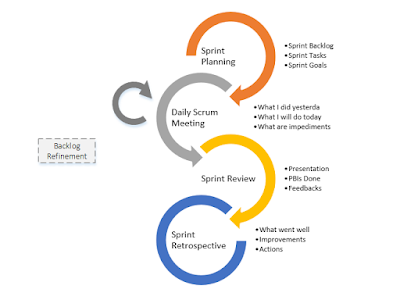What is Sprint?
- It's an iteration, time-boxed, regular & repeatable work cycle... within all project work takes place.
Why Sprint is known as a Container?
- Because it contains/hosts other Scrum Events/Ceremonies like Daily Stand-up, Sprint Planning, Backlog Refinement(Informal), Sprint Review and Sprint Retrospective.
 |
| SCRUM Ceremonies |
Why Backlog Refinement is called INFORMAL Ceremony?
- Because it doesn't take place at specific time. It's a continuous process and can happen at anytime throughout the Sprint. The Scrum guidelines suggests that Development Team should not spend more than 10% of their time for Backlog Refinement.
Sprint Planning
- It's beginning Ceremony for every Sprint. It is time-boxed, 8 hours for 4 weeks Sprint, less for shorter length Sprint.
- Inputs are: Product Backlog Items(PBIs) and Team's Velocity.
- Outputs are: Sprint Backlog and Sprint Goal.
- Product Owner, Scrum Master and Development Team are Mandatory Participants.
- Other Subject Matter Experts(SMEs), Business Analysts and Stakeholders may be invited to help the Team as needed for better understanding of subject and customer requirements.
- It has 2 parts. In the 1st part ("WHAT" part), Development Team selects User Stories and Sprint Goal is decided.
- In the 2nd part("HOW" part), Development Team breaks down User Stories into tasks and comes up with the plan on how to delivery Production Ready Increment by end of the Sprint.
Daily Scrum OR Daily Stand-up
- As name suggests, it takes place daily throughout the Sprint. It's 15 minutes time-boxed.
- At same place, same time to avoid confusions and preferably at staring of the workday.
- Development Team members are Mandatory Participants. If Scrum Owner and Product Owner are working on Sprint Backlog items then they can also Participate.
- Scrum Master makes sure that Daily Stand-up takes place, all Development Team member participates and it's not running longer than 15 minutes time-box.
- Every participant answer 3 questions.
- What did I do yesterday that helped the Development Team meet the Sprint Goal?
- What will I do today to help the Development Team meet the Sprint Goal?
- Do I see any impediment that prevents me or the Development Team from meeting the Sprint Goal?
- This is daily KEY Inspect and Adapt event for the Development Team toward the Sprint Goal. They Inspect their progress, make changes as required and Adapt new game-plan the day.
- The Development Team also updates Sprint Backlog items on Sprint Board. Based on these updates Sprint Burn-down chart is updated.
Backlog Refinement (INFORMAL Ceremony)
- It was previously knows as Backlog Grooming. They changed the wording from "Grooming" to "Refinement" to avoid confusion and alternate meaning.
- The MAIN Goal of this Ceremony is to bring User Stories into READY state as per the "Definition of Ready". This will help and save time of the Team during Sprint Planning.
- Inputs are : Incomplete User Stories and Product Backlog Items(PBIs).
- Outputs are : Ready User Stories and Product Backlog Items(PBIs).
- Product Owner and the Development Team are the Mandatory participants for the scheduled meeting.
- Any Scrum Team member can do the Refinement of Product Backlog at anytime subject to the approval from Product Owner.
- As per the Scrum guidelines, not more than 10% time of Development Team should go towards Backlog Refinement.
- As per the project complexity, Backlog Refinement Meeting can be scheduled more than 1 time.
- Ideally, it should be scheduled before couple of days of Sprint Planning. So, that Product Owner can order and prioritize the Product Backlog Items(PBIs).
Sprint Review
- It is also known as Demonstration Meeting.
- Customer, Product Owner, Scrum Master, Development team are Mandatory participants.
- Related Stakeholder and other interested parties are also invited.
- It's 4 hours time-boxed event for 1 month Sprint. Less time for shorter Sprint.
- Inputs are : Completed User Stories, PAST Increment and findings during the Sprint.
- Outputs are : Accepted User Stories, NEW Increment and updates to the Product Backlog.
- It's KEY Inspect & Adapt Ceremony for whole project for the Sprint.
- At beginning, Product Owner shares details about Spring Goal and what were the expectations.
- Then Development Team demonstrates working Product and invites attendees to Inspect and answers their queries.
- The Development Team also shares their new findings and any difficulties they faced during the Sprint.
- The Scrum team asks for the feedback from Stakeholders. All participant openly discusses their thoughts and next steps in the plan.
- Product Owner accepts completed User Stories based on "Acceptance Criteria" and "Definition of Done".
- Product Owner updates Product Backlog Items(PBIs) based on feedback received from Customer and Stakeholders.
- Based on all available inputs, Product Owner projects modified release plan and next steps.
Sprint Retrospective
- It's a last Ceremony before end of the ongoing Sprint.
- Scrum Master, Product Owner and the Development Team are Mandatory participants.
- Product Owner skips this Ceremony, if he is busy or Development Team members are not opening up in presence of Product Owner. This is NOT recommended by Scrum guidelines.
- It's 3 hour time-boxed for 1 month Sprint. Less for shorter Sprint.
- It's a KEY Inspect, Adapt and Improve meeting for the Scrum Team.
- Scrum Master facilitates and teaches but participates as peer Scrum Team member.
- Inputs are : Feedback and Updates receives from Sprint Review, Observations from the Sprint.
- Outputs are : Updates for "Definition of Done"and Improvements for the Scrum Team.
- Discussion is based on following 3 points...
- Inspect how the last Sprint went with regards to people, relationships, process, and tools.
- Identify and order the major items that went well and potential improvements.
- Create a plan for implementing improvements to the way the Scrum Team does its work.
- Identified Improvements are documented and assigned to the Team Member for the follow-up and accountability.
No comments:
Post a Comment